
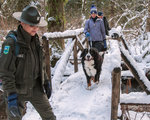


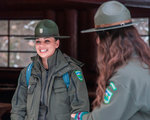

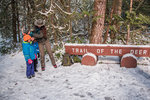
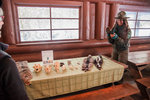
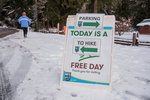
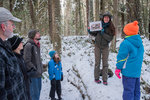
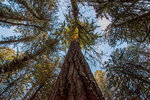
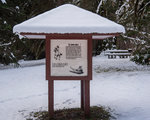

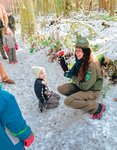
Sleeping in through a hangover on New Year’s Day or walking among 600-year-old Douglas fir trees? The choice is easy for rangers at Washington State Parks.
As one of many state parks “First Day” events, two rangers led a walk through Lewis and Clark State Park in South Lewis County on New Year's Day, ushering in 2022 with factoids on the forest and park history.
About 15 people of varying ages came along to begin their year trodding 2 miles through the snow. Walkers were led on the “trail of the deer” and the “old growth loop trail” by Alysa Adams, an interpretive specialist based in the Upper Cowlitz area, which includes Mount St. Helens, Lewis and Clark, Seaquest and Ike Kinswa state parks. Adams was accompanied by Corinthia Barnhart, a Lewis and Clark State Park ranger whose long career in the military ended last year when she came to work for state parks.
“This park is so special. They've kind of suggested to me a couple times maybe to transfer over to Seaquest, which is another park in our area. But I don't want to do it,” said Barnhart. “I love this park so much (and) the old growth forest.”
The group, which featured many kids and two large dogs, stopped at 10 checkpoints along the way to hear information on flora, fauna, work done there by the Civilian Conservation Corps (CCC) and many other topics.
One of only 11 interpretive specialists in the state, Adams creates and teaches curriculum on parks in the Upper Cowlitz area in-person at the Mount St. Helens visitor center, online and one-on-one with families at campsites. Most of her educational work is geared toward children.
She’s energetic and knowledgeable, spouting surprising facts constantly. These traits make her an approachable teacher for young ones, for whom she hopes to inspire a deep love of nature. Barnhart, a mother of young kids, said her children think of Adams as a celebrity after watching some of her informative YouTube videos. She often uses props and dance moves to get points across.
On one of the first stops, Adams had participants look to one side of the trail and compare it to another. With young alder trees on one side and towering Douglas firs on the other, the trail hugged the line where the Columbus Day storm of 1962 tore through the forest.
“What we're seeing here today is what we call 'succession:' the story of the transformation across the land,” Adams said. “Take a moment to see what we're looking at right now because I guarantee when you walk other parks and other natural landscapes, through your observation skills you will notice little things like this. You'll be able to piece together the story of the landscape without a ranger guiding you.”
Showing a photo of a Ford Model T beside an ancient Douglas fir, Adams had the visitors “time-travel” back through the history of the park. When it first opened in the 1920s, the park was seeing over 10,000 visitors a year.
It wasn’t until over a decade later that the CCC built bathrooms and a covered kitchen area, out of wood and stone from the grounds.
Adams also displayed a map of Lewis and Clark’s journey through America, proving they did not actually visit what is now their namesake state park. They ended their westward journey farther south at Cape Disappointment. But the park was named in their honor regardless, as it remains highly representative of the wilderness their party saw.
At another checkpoint, Adams enticed kids to learn about woodpeckers through a puppet of one and by passing around a model woodpecker skull, also called a “bone clone.”
She showed many of the bird’s incredible adaptations for its lifestyle, including a tongue more than twice the length of its beak that wraps around its brain as a cushion from the trauma of banging its head against a tree all day.
Moments after that lesson, a woodpecker flew past just over the heads of the group.
Using hands-on learning, storytelling and jokes, Adams hopes to empower park visitors to understand the world around them in a way that’s mutually beneficial for themselves and the environment.
“You can all be citizen scientists wherever you are at, using your own field (of knowledge) to kind of put together the story of nature all around you,” Adams said to the group. “The trees really do talk. Just not in our language, right?”
Lewis and Clark State Park facilities will remain closed until May 1, but walking through the park is still permitted. For virtual learning curriculum by interpretive rangers, visit https://parks.state.wa.us/1197/Virtual-Learning-Opportunities-in-Parks or head to the Washington State Parks YouTube channel.